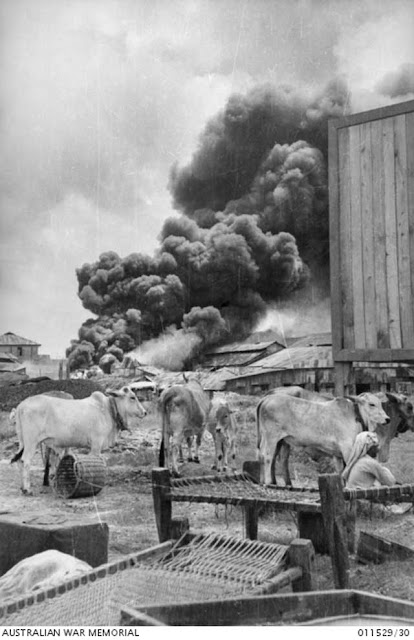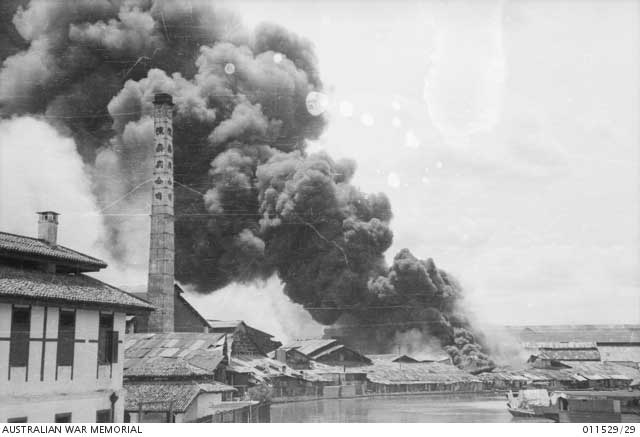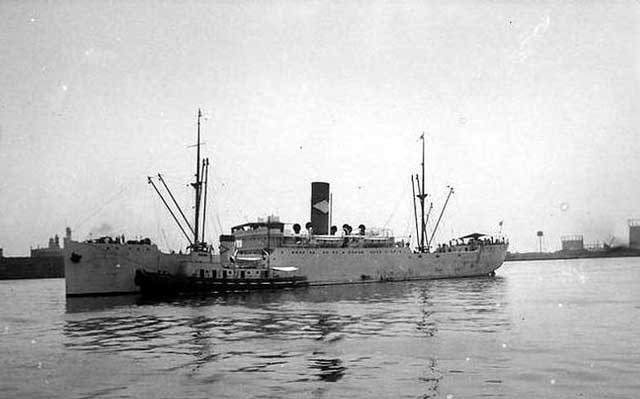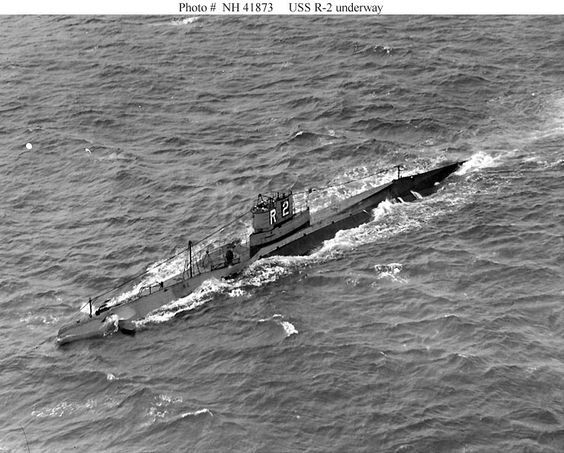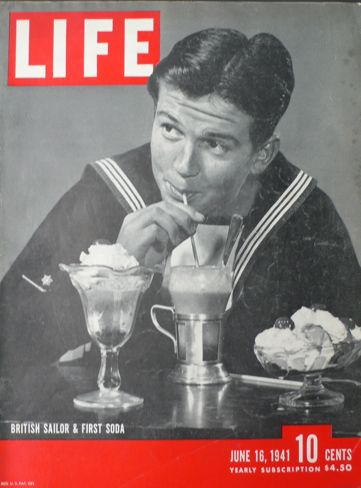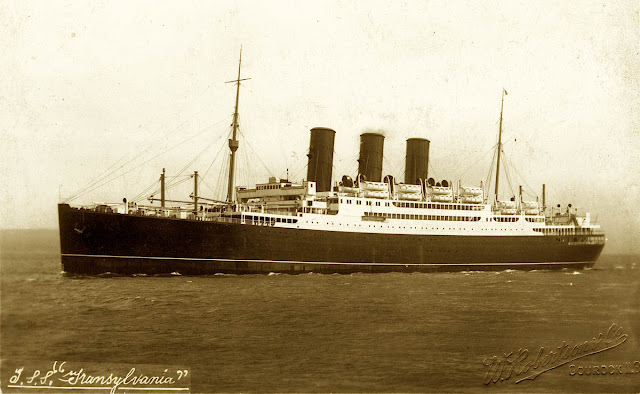Monday 16 June 1941
 |
| "The Cheshire Yeomanry patrolling on horseback at Marjuyan in Syria, 16 June 1941." "At the outbreak of war, the British Army had only eight mounted units. Its cavalry horses last saw action in the Middle East during 1940-1942 where they were used for patrol and reconnaissance work" (Major Geoffrey Keating, © IWM (E 3593)). |
Syrian/Lebanon Campaign: Operation Exporter continues. The Battle of Kissoué, which controls access to Damascus, reaches a climax on
16 June 1941. Vichy French resistance has stiffened, and a company of the 7th Chasseurs d'Afrique advance to take Quneitra (Kuneitra or El Quneitra) from the Royal Fusiliers. The French tanks surround the town and at 19:00 take 13 British officers and 164 other ranks prisoner.
The French thus save Damascus for the moment. However, the British remain on the offensive by bringing in the 16th British Brigade from Egypt (diverted from other operations). This forces the Vichy French to withdraw their forces attempting to outflank the advancing British and prepare for a frontal defense. During the French withdrawal, British troops take up positions above the road the French must use and kill over 50 troops before withdrawing during the night.
The Vichy French are held at Jezzine, which the 25th Australian Brigade holds with difficulty. At Merdjayoun, Brigadier Berryman takes command.
The war at sea heats up. Vichy destroyer Chevalier Paul, carrying supplies to Syria and Lebanon, is sunk near Latakia by British Swordfish of RAF No. 815 Squadron (one plane shot down). There are six deaths and nine wounded. French destroyers Valmy and Guepard pick up the survivors. While they withdraw, Guepard and Valmy are damaged by Royal Navy destroyers Jervis and Kimberley.
Another French destroyer, Vaquelin, makes port in Beirut with supplies, but the RAF damages it there. The Royal Navy, meanwhile, continues providing support to the Australians advancing north from Sidon.
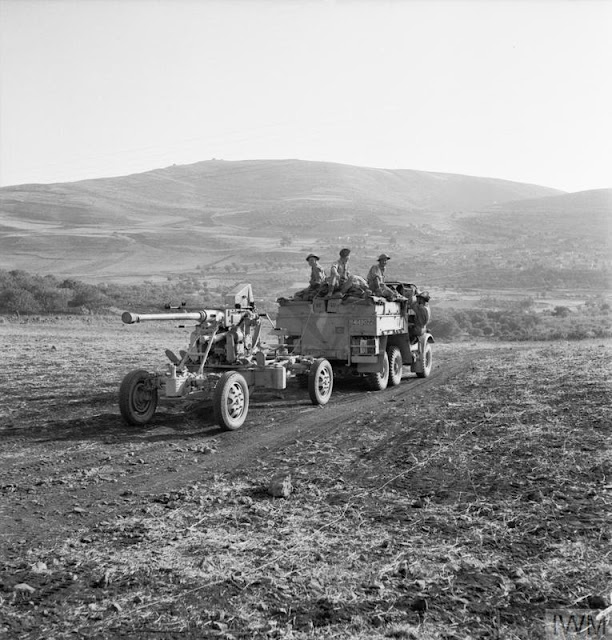 |
| "40mm anti-aircraft gun being towed in Syria, 16 June 1941." (Major Geoffrey Keating © IWM (E 3561)). |
European Air Operations: The Luftwaffe raids Gloucester with 60 bombers.
RAF Bomber Command sends three Blenheims of No. 21 Squadron on a special mission to sink trawlers parked in the North Sea to act as a primitive early-warning system. These trawlers are known to the British as "squealers." The Blenheims, flying at wavetop level, manage to sink a squealer but lose a Blenheim when it hits one of the trawlers' masts.
RAF Bomber Command sends 25 planes on an anti-shipping mission.
The RAF conducts "Circus No. 14." This is a raid on Boulogne, with ten No. 11 Group fighter squadrons escorting ten Coastal Command Blenheim bombers. Luftwaffe fighters of elite I,/JG 26 (Adolf Galland) intercept the formation, and the RAF loses two Blenheims and nine Supermarine Spitfires. The Luftwaffe loses four Bf-109s, and two of the pilots perish.
During this action, Lt. Joseph "Pips" Priller shoots down a Spitfire and a Blenheim over Boulogne. Galland, meanwhile, downs a Hurricane. Both men will wind up the war with 100 victories (Galland with 104, Priller with 100) and are considered two of the greatest fighter pilots of the war - if not all time.
After dark, RAF Bomber Command sends 105 bombers to attack Cologne, 72 to attack Dusseldorf and 39 to attack Duisburg.
 |
| HMS Rapid (H32) - R class destroyer. Ordered: 1 April 1940. Laid down: 16 June 1941. Launched: 16 July 1942. |
Battle of the Atlantic: British invasion fears continue during prime summer weather. Upon unconfirmed reports of a German sortie from Brest, the Home Fleet is brought to one hour's notice. However, the ships leaving port are only freighters and the alert is canceled.
The Luftwaffe bombs and damages 167-ton British trawler Atlantic three miles southeast of Eddystone. The Atlantic makes it back to Plymouth.
German Patrol Vessel (Vorpostenboot) V-5606 runs aground near Vagsoy, Norway. The 204-ton former whaler ("Treff") is a write-off and eventually sinks in 35-45 meters of water. It remains in good shape and is a dive site.
Royal Navy minelayers Agamemnon and Menestheus lay minefield SN-66 in the Iceland Faroe field. This has been a favored breakout point for German surface raiders into the Atlantic.
Convoy OB-335 departs from Liverpool bound for Halifax, Convoy HX 133 departs from Halifax.
Royal Navy corvette HMS Bryony is commissioned, minesweeper Seaham is launched, and destroyers Rapid and HNLMS Kortenaer (nee Scorpion) are laid down.
Canadian corvette HMCS Vancouver is laid down at Esquimalt, British Columbia.
United States USS Gansevoort and Gillespie are laid down.
U-406 is launched, U-220, U-221, and U-222 are laid down.
 |
| An Afrika Korps soldier gets out of his Panzer III, June 1941. |
Battle of the Mediterranean: It is Day 2 of Operation Battleaxe, the latest British attempt to push the Germans and Italians back from the Libyan frontier and relieve Tobruk. Today does not go any better than the opening day of the offensive for the British, and it runs tight today due to smart and quick German ripostes.
The 11th Infantry Brigade attacks into Halfaya Pass, a critical objective that divides the front into thirds, with the pass being the center section. Afrika Korps Major Wilhelm Georg Bach controls the outnumbered Axis forces in the Pass, and the British quickly surround him. Bach, an unorthodox officer who flouts Wehrmacht convention by being indifferent about his attire and kindly to his men, is an expert with 88 mm flak guns being used in an anti-tank role, and he puts his skills to good use. He holds out throughout the day and continues destroying British tanks. This is the linchpin of the German defense, and it holds despite great privations.
General Walter Neumann-Silkow, the Commander of the 15th Panzer Division, attacks the lone British success of the opening day of the British offensive, Fort Capuzzo, at 06:00. Neumann-Silkow has 80 tanks and forms them into two columns. Like the British in Halfaya Pass, however, the advancing panzers run into the fierce anti-tank fire from 25-pounders and tanks hull-down in well-chosen defensive positions. The panzer force loses 50 tanks within four hours, and the attack is over by noon. This is a mirror-image of the failed British tank attack on Halfaya Pass and Hafid Ridge on the 15th. This failure frees the Scots Guards to pursue them, and the British take the Sollum barracks on the east flank. This further isolates Bach in Halfaya Pass.
Meanwhile, the German 5th Light Division also attacks down the coastal sector at dawn. It rolls southward past Hafid Ridge, shadowed by the 7th Armoured Brigade and 7th Support Group. The panzers once again demonstrate their superiority over the British tanks, standing off and shelling the British while still out of range of British tank fire. The Germans thereby eliminate their true threat - the vulnerable towed British 25-pounder anti-tank guns. Once those are gone, the Panzer IIIs (50 mm gun) and Panzer IVs close and destroy the thinly armed British cruiser tanks. The battle goes so poorly for the British that they have to retreat not just to their starting positions, but east of them - losing ground. The day ends with 5th Light continuing to harass the retreating British tank force.
General Erwin Rommel keeps close tabs on the battle and notices the brilliant success on the flank by the 5th Light Division. At 16:00, Rommel orders the 15th Panzer Division to leave only a screen against the advancing Scots Guards and shift its tanks to support 5th Light's advance. The British at first try to continue attacking into Halfaya Pass, but after dark the British accept defeat. They consolidate their remaining Matilda Tanks (over half have been destroyed) as a blocking force while the British infantry withdraws back into Egypt. The British only have 21 cruiser tanks left in the 7th Armoured Brigade and 27 Matildas in the 4th Armoured Brigade.
The events of 15 June effectively end Operation Battleaxe. However, the battle is not over. Now, the Afrika Korps is on the offensive due to superior equipment and tactics. While the British Army still holds Fort Capuzzo, the Germans are advancing into position not only to cut them off but stream further east into Egypt.
Overhead, Luftwaffe ace Hans-Joachim Marseille takes damage to this fighter in the aerial battles over the battle. Oil spraying on his windshield blinds him, but he is "talked down" to a safe landing by flight leader Reiner Pöttgen.
At Malta, a Wellington bomber arriving from Gibraltar crashes in the sea on approach to Hal Far airport. The entire crew perishes. Another Wellington fails to arrive and is presumed lost.
 |
| British propaganda dropped on Germany, 16 June 1941 (EH.510/4, Luftpost, Nr. 4, 16. Juni 1941Psywar.org). |
POWs: Realizing that his peace mission has failed and that Germany faces a two-front war, Rudolf Hess throws himself down a flight of stairs at his place of confinement in Aldershot in order to commit suicide. However, he only manages to break his leg.
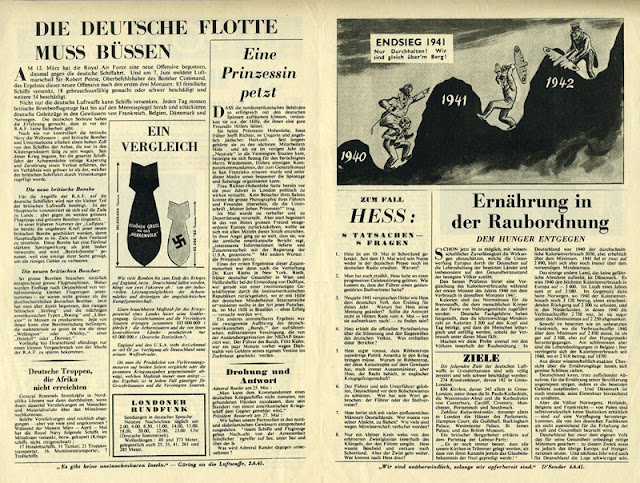 |
| The reverse side of the 16 June 1941 British propaganda leaflet (EH.510/4, Luftpost, Nr. 4, 16. Juni 1941Psywar.org). |
Anglo/US Relations: Prime Minister Winston Churchill makes a stirring
radio speech from London that is broadcast in the United States. It is a brief three-minute speech, but very effective. The occasion is the University of Rochester awarding Churchill an Honorary Degree of Doctor of Laws, his first honorary degree from the United States. In a speech entitled "The Birth Throes of a Sublime Resolve (‘The Old Lion’)," Churchill says in part:
But what is the explanation of the enslavement of Europe by the German regime? How did they do it? It is but a few years ago since one united gesture by the peoples, great and small, who are now broken in the dust, would have warded off from mankind the fearful ordeal it has had to undergo. But there was no unity. There was no vision. The nations were pulled down one by one while the others gaped and chattered. One by one, each in his turn, they let themselves be caught. One after another they were felled by brutal violence or poisoned from within by subtle intrigue.
England, he implies, now is the "old lion with her lion cubs at her side" standing ready to deter aggression, alone against hunters who are armed with deadly weapons and impelled by desperate and destructive rage" after the others have been overcome. It is classic Churchill, one of his best speeches.
 |
| Winston Churchill addresses the American people, 16 June 1941. |
US/German Relations: Further to his recent Executive Order freezing German, Italian, and other European assets connected to the Axis, President Roosevelt orders the closing of all German consulates (other than the embassy in Washington D.C.) by 10 July. All related personnel must return to Germany. This includes ancillary services such as the German Library of Information in New York City, the German Railway and Tourist Agencies, and the Trans-Ocean New Service. The reason given is that these German services "have been engaged in activities...of an improper and unwarranted character" and "wholly outside the scope of their legitimate duties." These activities are "inimical to the welfare of this country."
The Germans, of course, quickly respond in kind.
 |
| Chinese General Chen Chang on the cover of Time magazine, 16 June 1941 (Boris Artzybasheff). |
US/Japanese Relations: The US Ambassador in Tokyo, Joseph Grew, delivers a diplomatic protest over Japanese Imperial Air Force flights over the US naval base at Guam on 11 and 14 June. The Japanese government denies any culpability in the matter. Grew, incidentally, is wary of Japanese intentions, having cabled Washington in January 1941 with warnings of a brewing Japanese attack.
German/Italian Relations: Italian Foreign Minister Count Galeazzo Ciano meets with German Foreign Minister Joachim Ribbentrop in Venice. Ribbentrop denies rumors of a pending German attack on the Soviet Union. He does say, though, that should war break out, Germany would win quickly.
 |
| Aerial reconnaissance of Kharkiv, the fourth-largest city in the Soviet Union and the most fought-over city in Russia. |
German Military: Luftwaffe General Eugen Meindl, commander of Meindl Group during Operation Mercury on Crete until badly wounded at Platanias Bridge, receives the Knight's Cross.
Field Marshal Albert Kesselring meets with Field Marshal Fedor von Bock. Kesselring commands Luftflotte 2, which is to operate in support of Bock's Army Group Center (Heeresgruppe Mitte) on the road to Moscow. Kesselring and others move to their forward headquarters in anticipation of the 22 June 1941 scheduled start to Operation Barbarossa.
Reich port authorities are ordered to prevent any Soviet vessels from leaving. German U-boats already have carte blanche to sink Soviet vessels, so this is probably a necessary move because U-boats are lurking around all Baltic ports.




